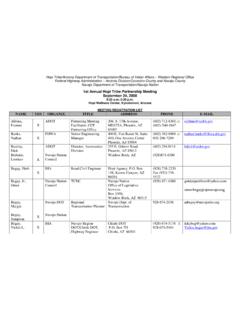Transcription of People of the Land: Sustaining Agriculture on the Hopi ...
1 H O P I. People OF THE land . Sustaining Agriculture on the Hopi Reservation CM-14-02. Loretta Singletary Interdisciplinary Outreach Liaison, University of Nevada Cooperative Extension Staci Emm Extension Educator, University of Nevada Cooperative Extension Micah Loma'omvaya Natural Resources Planner, Hopi Tribe Janine Clark University of Nevada, Reno, NSF-REU Undergraduate Student Scholar Matthew Livingston University of Arizona FRTEP Extension Educator, Hopi Reservation Michael Kotutwa Johnson University of Arizona, Doctoral Student, American Indian Studies Ron Oden Media Production Specialist, University of Nevada Cooperative Extension A Partnership of Nevada Counties; Project Funded by WSARE.
2 University of Nevada, Reno; Professional Development Program Grant and Department of Agriculture in Partnership with: Federally Recognized Tribal Extension Program CM-14-02. Copyright 2014, University of Nevada Cooperative Extension. All rights reserved. No part of this publication may be reproduced, modified, published, transmitted, used, displayed, stored in a retrieval system, or transmitted in any form or by any means electronic, mechanical, photocopy, recording or otherwise without the prior written permission of the publisher and authoring agency. The University of Nevada, Reno is committed to Equal Employment Opportunity/Affirmative Action in recruitment of its students and employees and does not discriminate on the basis of race, color, religion, sex, age, creed, national origin, veteran status, physical or mental disability, and sexual orientation.
3 The University of Nevada employs only United States citizens and aliens lawfully authorized to work in the United States. Women and under-represented groups are encouraged to apply. A. TABLE of CONTENTS. Title Page A. Chapter 1: The Hopi: Our People of Long Ago 1. Hopi Cultural Ceremonial Calendar Mural (Pull-out) 7. Chapter 1 Review 14. Chapter 2: Hopi land Base 16. Map Page of History of Executive Orders (Pull-out) 26. Chapter 2 Review 29. Chapter 3: Hopi Tribal Governance 31. Chapter 3 Review 36. Chapter 4: Agricultural Irrigation and Water Rights on the Hopi Reservation 37. Chapter 4 Review 47. Chapter 5: Agricultural and Natural Resource Challenges on the Hopi Reservation: Results of a Needs Assessment 49.
4 Chapter 5 Review 54. Chapter 6: Focus Group Research Methodology and Results 55. Chapter 6 Review 67. Chapter 7: Implementing Agricultural and Natural Resource Programs on the Hopi Reservation 69. Chapter 7 Review 75. Appendix A: Hopi [Moqui] Petition for Title to land 77. Bibliography: Chapter 1 94. Chapter 2 96. Chapter 3 97. Chapter 4 98. Chapter 5 100. Chapter 6 101. Chapter 7 101. 1. C H A P T E R O N E. The Hopi: Our People of Long Ago 1. Learning Objectives: n Explore early Hopi culture and history n Examine the physical and socioeconomic characteristics of the Hopi Reservation n Discover the dryland agricultural practices used on the Hopi Reservation today The Hopi People are descendants of ancient agrarian societies.
5 This chapter provides a brief overview of the early history of the Hopi People and specifically the role of Agriculture as a foundation for the Hopi culture. Physical attributes of the land and current socioeconomic trends on the Hopi Reservation are described. Traditional dryland farming practices that still characterize Hopi Agriculture today are highlighted. Hisatsinom Our People of Long Ago The Hopi refer to their ancestors as Hisatsinom or Our People of Long Ago. The Hopi are descendants of some of the oldest human settlements discovered in the Americas. In fact, archaeological evidence suggests that the Hopi descended from sedentary agrarian cultures dating back to 10,000 , including the ancestral Puebloans, Mogollon, Hakataya and Hohokam (Pearlstone, 2001).
6 Archaeological evidence dating to 1100 has produced remnants specific to the ancestral Puebloans who lived above ground in stone block townhomes located near present-day Hopi mesas. A pervasive and severe drought between 1275 and 1300 is thought to have caused these ancient towns to disappear. Their descendants, the Hopi, then migrated to the region of the Hopi mesas (Donahue & Johnston, 1998). Creation Story According to Hopi oral history, the Hopi occupy the fourth world , having emerged from three underworlds by climbing up a reed (Bonvillain, 2005; Courlander, 1971). Upon arrival, they found a land covered by water with three mesas, and there they met Maasaw, the deity and ruler of the fourth world.
7 Maasaw presented the Hopi with three gifts that symbolized life principles. These were corn seeds, a gourd filled with water and a planting stick. Corn (qaa'o) was to be the soul of the Hopi People . The planting stick (sooya) would provide simple but dependable farming technology. Maasaw warned the People against reliance upon technologies that had overtaken the third world and had led to discontent, materialism and greed. The water gourd (kuywikoro) represented the Creator's blessing and the Hopi's relationship with the natural environment. Maasaw formed a sacred covenant with the Hopi and foretold of difficult and challenging times that lie ahead; but if the Hopi held fast to the covenant, they would live long and spiritually full lives (Mails & Evehema, 1993; Donahue & Johnston, 1998).
8 Maasaw instructed the People that in order to live on the mesas, they needed first to travel to distant lands to acquire knowledge useful to Hopi society (Gilbert, 2010). The People divided into clans and migrated to each of the four cardinal directions. 1. During their travels, the Hopi learned how to survive a range of environments. They encountered a variety of insects, animals and plants with which they identified and whose names they adopted to identify their clans. The People learned from and exchanged ideas with many other cultures. Each founding clan returned to the mesas from the four cardinal directions to contribute to Hopi society something meaningful they had learned and experienced during their migrations (Gilbert, 2010).
9 Today, the Hopi sustain their deep connection to the land established in the covenant with Maasaw and follow the Hopi way . through embodying the Hopi values: cooperation, humility, hard work and stewardship . (Balenquah, 2012, Page 64). Hopi Reservation A executive order issued by President Chester A. Arthur on Dec. 16, 1882 set aside million acres of land in northeastern Arizona for the use of the Hopi and other Indians.. Through a series of federal legislative actions, the Hopi Reservation today comprises approximately million acres (Tiller, 2005). Located within the Great Basin Desert on the Colorado Plateau, the Hopi Reservation encompasses and extends beyond the southern edge of Black Mesa.
10 The southern escarpment breaks off sharply to form the broad, flat Little Colorado River Valley. The southern scarp of Black Mesa forms a series of individual, narrow mesas called Antelope Mesa, First Mesa, Second Mesa, Third Mesa, Howell Mesa and Coalmine Mesa (Suderman & Loma'omvaya, 2001). Since the first official contact with federal Indian agency representatives during the 1870s, the number of Hopi villages has increased from seven to 12 currently occupied villages. These are located primarily on or around First, Second and Third Mesa. Some tribal members reside in small, outlying communities surrounding these primary villages. The most recent Census estimates the Hopi Reservation population at 7,185 ( Census, 2012).











